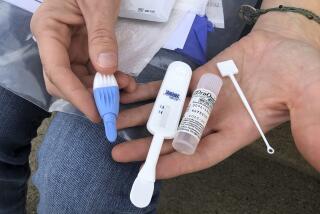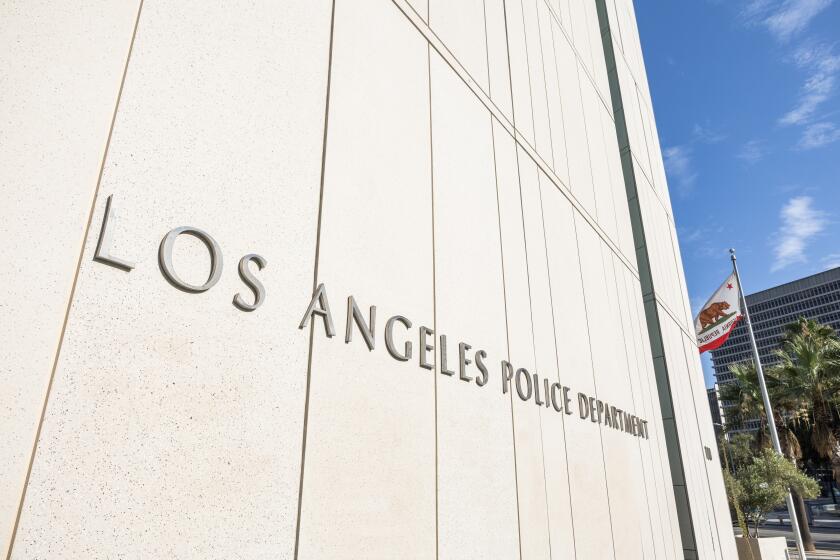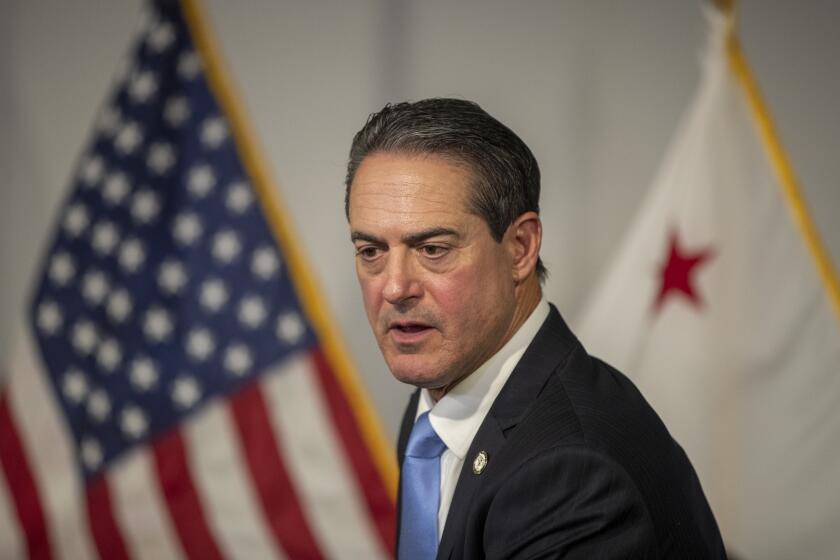AIDS Ward Hit by Staff, Space and Money Shortages
- Share via
Thursday is a dreaded day at 5P21. The corner ward in the hectic Los Angeles County-USC Medical Center has no sign on its entrance, in order to ensure privacy. But more than a third of Los Angeles’ spiraling population of AIDS patients know 5P21 as the only place they can go for regular outpatient treatment of their disease.
On Thursdays, 5P21--the hospital’s AIDS Outpatient Clinic--schedules blood transfusions and chemotherapy for its clients. All day, dozens of haggard men and women crowd into the clinic’s narrow corridors, waiting on hard wooden benches for their appointments. Oxygen tanks and intravenous liquid poles clutter the narrow walkways. Often, patients get chemotherapy and other treatments at their benches because there is no room left in the clinic’s 10 examining rooms.
“It really gets you down,” said Robert Dawson, 34, a West Hollywood resident who has AIDS-like symptoms and has been coming to the clinic for three years. “It seems to be worse every time I come back.”
Some Wait for Hours
The crush at the clinic, which averages 60 visits a day, is not much better during the rest of the week. Though patients with painful symptoms can get immediate help, others with less pressing needs can linger for hours before they are seen. And patients who have tested positive for the human immunodeficiency virus--who have no symptoms, but want to be treated in hopes of forestalling the disease--have to wait up to eight weeks for appointments at the clinic.
Like so many other beleaguered units at the public hospital, 5P21--the largest clinic in the county available to AIDS patients who need public assistance--is desperate for more space and more staff, and short of money to pay for them. Moreover, 5P21’s woes have come at a time when AIDS specialists have begun viewing outpatient clinics as a crucial component in delaying the progressively lethal complications caused by AIDS.
“Those of us who deal with AIDS see the outpatient clinic as the major development in AIDS care over the coming years,” said Dr. Martin Finn, medical director of the county’s AIDS program office. “The emphasis is on keeping the AIDS patient out of the hospital as much as possible.”
In recent weeks, local AIDS activists have made the clinic the latest target in continuing clashes with Los Angeles County officials over the handling of AIDS issues. After successfully prodding the county to commit funding to an AIDS hospice and to develop a special ward at County-USC Medical Center for patients who have AIDS, activists have made the clinic their latest cause.
Funds Unavailable
“They are falling further and further behind in care for people with HIV infection,” said Michael Weinstein, head of the Los Angeles Hospice Foundation. “They need immediate action.”
Clinic officials say they are discussing plans for changes, but caution that funding for a quick fix is unavailable. “I think our hospital administration deserves medals for the creative ways they’ve tried to get us what we need,” said Dr. John M. Leedom, chief of the hospital’s Infectious Diseases Unit.
The clinic opened in March, 1985, after hospital officials realized that they had fallen behind in efforts to tend to the needs of AIDS patients who were well enough to stay out of the hospital but still required treatment. As the numbers of AIDS patients in Los Angeles have mushroomed--there are now an estimated 3,000 diagnosed with HIV infections--so has the patient load at the clinic. More than 1,000 patients regularly visit 5P21, said the clinic’s director, Dr. Fred R. Sattler.
Nearly 740 patient visits were recorded in January, 1987. By last August, the average monthly number of visits had jumped to 1,420. Similarly, the clinic expects its daily load of visits to increase from its average of 60 a day now. “We anticipate demand to increase to 100 to 110 visits a day by this time next year,” Leedom said.
Overwhelmed by Patient Load
As the federal government and other agencies have made experimental AIDS treatments available, more patients have been able to avoid long hospital stays and use the clinic as their primary care source. Hospital beds are freed up, but at 5P21, the benches have filled.
The county’s critics acknowledge that the clinic’s staff is, as Weinstein says, “compassionate and hard-working.” But they contend that the staff of less than 20 full-time doctors, nurses and social workers is overwhelmed by the patient load and hemmed in by a shortage of examining rooms and needed equipment.
Chris Brownlie, an activist and AIDS patient who has been a regular client at the clinic, says that 5P21’s atmosphere is “something out of Dante.” He described patients overwhelmed by nausea and vomiting in brown paper bags after being administered grueling chemotherapy treatments in front of fellow AIDS victims.
One clinic staff member, who declined to be identified, agreed with that stark picture. The staff member said that doctors are sometimes forced to ask AIDS patients to strip to their waists in front of other patients so that their cancerous lesions can be examined. “Those kinds of things should be done in private,” the staff member said. “We wish we could offer them better facilities.”
The clinic’s high-ranking doctors, too, are disheartened by the environment. But they bridle at grim descriptions of the clinic in local gay newspapers that Leedom said “make us look like a leper colony.”
2-Floor Clinic Planned
Leedom said that there are plans to build a separate, two-floor AIDS clinic on a nearby section of the hospital grounds. But the building, which would take at least a year to construct, would require as much as $1 million in funding, which Leedom said “is just not available yet.” Other officials say construction on a new clinic is at least two years off.
Doctors at the clinic hope to temporarily cut down on the eight-week waiting period for newly diagnosed AIDS patients in coming weeks by adding two new staff members expected to be paid from federal funds. Sattler and Leedom acknowledged that they were concerned about the long waiting period because newly diagnosed AIDS patients are prone to developing symptoms that they might not recognize--symptoms that might go untreated until they finally showed up weeks later for their appointments.
Pointing out the continuing danger to AIDS patients whose conditions may be worsening while they wait, activists have demanded quick action from the county. In August, Weinstein wrote a letter to Rabbi Allen J. Freehling, chairman of the County AIDS Commission, asking for the creation of a task force on clinical treatment. Steven Gamble, the head of the commission’s Service Committee, said a proposal for such a task force will be taken up soon.
Weinstein also believes that the county should make plans for a temporary expansion of the clinic within the next 45 days. “They’re not trying hard enough to come up with stopgap solutions,” he said.
The doctors who work with the legions of AIDS patients who show up at 5P21 five days a week see no immediate end in sight. “We’re in the same boat as a lot of other departments at the hospital,” Leedom said. “It doesn’t make it right, but we do what we can with the limits we’ve got.”
More to Read
Sign up for Essential California
The most important California stories and recommendations in your inbox every morning.
You may occasionally receive promotional content from the Los Angeles Times.













